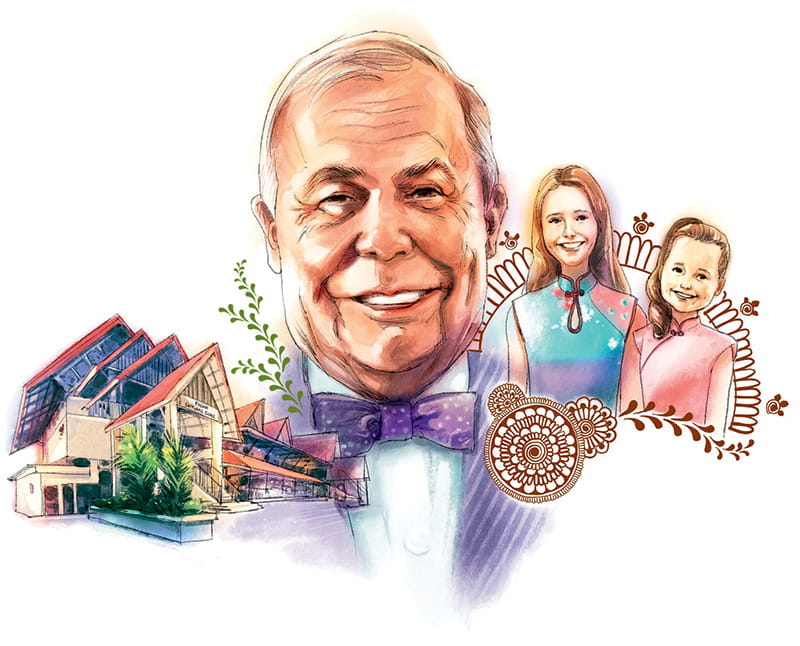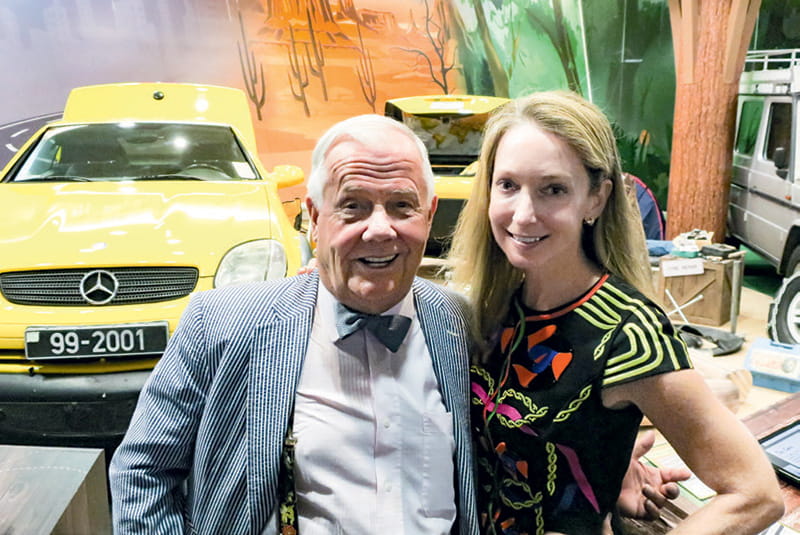Stories > A Worldly View
A Worldly View
American investor Jim Rogers believes that Singapore offers the best of East and West in a highly globalised world.
BY SHWETA PARIDA
ILLUSTRATOR KEN LEE
couple of months ago, a barrel of monkeys descended on the patio of Jim Rogers’ house located a stone’s throw from the Singapore Botanic Gardens, and lingered around for an hour or so.
It was an episode that left the American billionaire rather amused. “Where else in the world can you live in such a vibrant and modern city and yet be so close to nature?” he asks incredulously.
The 77-year-old investor, who has a global index fund named after him, and who co-founded one of history’s most successful investment funds along with American investor George Soros, moved to Singapore in 2007. Having decided that he wanted to raise his two daughters in Asia, Rogers set out to find a city that could offer his family an international, cosmopolitan experience, and most importantly a real knowledge of Mandarin. “It’s the most important language of our time,” he emphasises.
EMBARKING ON AN ASIAN ODYSSEY
His quest led him to explore Hong Kong and Shanghai in 2003 and, finally, Singapore. “Although I had visited here previously in the ‘80s, it was purely for business. What really sealed the deal for our permanent move was the fact that my children could get world-class education in a multicultural environment, and learn Mandarin in the most authentic manner,” he says.
He also insisted that his daughters, Happy, 16, and Bee, 12, attend local school rather than an international institution as most expat children are wont to do. Both studied at the prestigious Nanyang Primary School, a place Rogers describes as the best school he could have asked for.
“I was teaching my daughters Mandarin even before they moved to Singapore,” he says. “People told me that they will stop speaking the language by the age of 10. So I decided that I’ll move to a place where they will have no choice but to speak it.”
While a Chinese city would have been the perfect choice for total immersion in the language, the smog concerns at the time dissuaded him to move there.
His fascination with Asia and the desire to move to the region started way before he took the plunge. The adventurer in him rode a bike around the world back in the ‘90s that resulted in his book Investment Biker, followed by another round-the-world expedition in a car with his wife, Paige Parker, that prompted him to write yet another memoir: Adventure Capitalist.
Recounting his first impression of the island state, he says that his first business trip here did not go as planned in terms of an acquisition. Despite the unsuccessful business deal, his opinion about Singapore has remained unchanged – that it is among the most well-run countries in the world.
“To me, the greatest draw was that everything in Singapore works efficiently – from healthcare to transportation and education. In fact, Singapore produces some of the most extraordinary educators I have ever seen,” says Rogers, who studied at Yale University and the University of Oxford.

American investor Jim Rogers believes that diversity of language, religions and races is an everyday lived experience in Singapore.
A MEASURE OF SUCCESS
How has his perception of the country changed since his first visit? “My impression of Singapore has always been of a country that runs on efficacy and long-term planning,” he says. “Half a century ago, it had swamps and inadequate infrastructure, but founding Prime Minister Lee Kuan Yew and his team’s vision transformed the country. I don’t think there is any other country that has been as successful as Singapore in the past 40 years.”
Being the astute investor that he is, Rogers is well aware of the challenges the country would have faced to attract investors and build a successful economy in its initial days of independence. “Singapore’s pioneer leaders did their best to get smart, highly educated people to come here, and enforced a high rate of savings,” he shares his observations. “Any economist will tell you that you need savings and investments to run a proper economy. On my first trip here, I was startled at the high rate of savings by both the government and the people.”
Rogers also admires the fact that the nation’s first prime minister insisted on quality education and bilingualism that led the authorities to launch campaigns to encourage Singaporeans to speak good English and mother tongue languages – Mandarin, Malay and Tamil.
“The strategic location of Singapore has established it as one of the world’s most important trade routes for the past few centuries. But 100 years ago, most people knew of Singapore only as a trading port, or as a British colony.”
“Singapore Has A ‘We Are In This Together’ Community Spirit, Especially During A Crisis. This Is Evident In How Most Companies Here Have CSR Programmes In Place That Not Only Give Back To Singaporeans But Also Reach Out To The Underprivileged In Other Countries.”
He further adds: “It’s a country of a little over five million people with not much manufacturing capabilities, but if you are in the world of finance, you name Singapore in the same breath as New York, London and Tokyo – among the great global players. In shipping and commodities trading, Singapore punches far above its weight.”
With the economic success, Rogers says that Singapore’s corporate culture has also undergone a shift – from a balance sheet-oriented approach to that of a community-centred objective.
“Singapore has a ‘We are in this together’ community spirit, especially during a crisis – a lot more than most countries,” he says.
“This is evident in how most companies here have corporate social responsibility [CSR] programmes that not only give back to Singaporeans but also reach out to the underprivileged in other countries.
“For instance, companies such as CapitaLand, DBS Bank, UOB and Microsoft Singapore have several CSR programmes locally as well as funding and support for initiatives in Asia.”
IMMERSED IN CULTURAL PURSUITS
Since arriving here, the entire Rogers family has become involved in various arts and culture activities. “There are many good cultural initiatives such as the Singapore Symphony Orchestra [SSO], theatres, and lots of international entertainers come to perform here,” he notes. “There are so many galleries and museums – we especially love visiting the National Museum.”
The Rogers family’s passion for the arts is not just limited to enjoying the cultural offerings. While Parker (pictured above with Rogers) is an arts patron and supports outfits such as the SSO, in addition to being a columnist for The Straits Times and a member of the Singapore Committee for UNWomen, the couple’s children have carved out a niche of their own.
Often recognised as the “angmoh” (Hokkien for people of Caucasian ethnicity) girls who speak fluent Mandarin, Happy and Bee have grown to be young cultural purveyors – from local theatre to food.
Just how much the family has assimilated into the local community is evident in the programmes they have embedded themselves into.
“Back in 2008, my daughters auditioned for roles in Wild Rice theatre productions, and since then they have been involved in several plays,” he recalls.
“Happy was one of the prefects in primary school. Now, my younger daughter has become the vice-head prefect. They had never had any Caucasians in these positions before in its over 100-year history.”
However, he is quick to add that in the beginning he had apprehensions about how his wife will respond to Singapore. This, he says, is because she grew up in a small town in the state of North Carolina.
“Paige’s first exposure to multiculturalism took place in New York,” he shares. “When we went on a round-the-world adventure, it was a shock for her. But in Singapore, multiculturalism has become a way of life for us. Personally, I find that Singapore offers a more immersive multiculturalism than New York because you experience it on a daily basis. It’s common to walk down a street that has a Hindu temple next to a mosque that is right next to a church building or a Buddhist temple – all of them co-existing in harmony.
“In the same vein, a visit to Little India can give you a glimpse of a completely different side of the island state. I’d describe it as cultural concentration with a window to the world without any barriers. You can experience a completely different culture in all its authenticity right here.”
The peripatetic investor says that the way of life here has certainly broadened the entire family’s perspectives on diversity.
“Personally, I Find That Singapore Offers A More Immersive Multiculturalism Than New York Because You Experience It On A Daily Basis. It’s Common To Walk Down A Street That Has A Hindu Temple Next To A Mosque That Is Adjacent To A Church Building Or A Buddhist Temple.”
“While most of our friends here are Singaporeans of different races, we have also made friends from India, South Korea, Japan and Malaysia,” he shares.
Over the years, the American investor has formed his own viewpoint about Singaporeans. “I have realised that they have a very global perspective, so they actively participate in discussions that may not have a direct bearing on them as individuals. But it reflects their curiosity, and the fact that they are well plugged into international affairs,” says Rogers, citing the example of the US elections and how fervently his erudite Singaporean friends discuss the topic.

Rogers wanted his daughters, Happy and Bee, to learn Mandarin in a multicultural environment. The girls also participate in Chinese cultural programmes.
His views on the country and its people have led him to realisations about his own life here. “While most Singaporeans might know short-term American expats, I don’t think we are among them. For us, this is home, and so our perspectives are borne out of our lives here,” he concludes.
